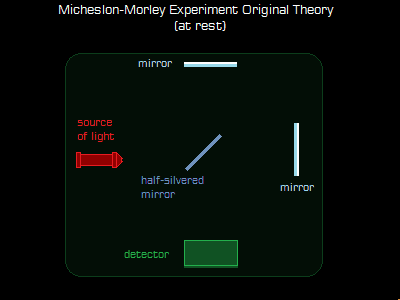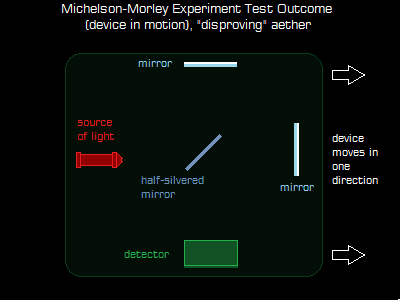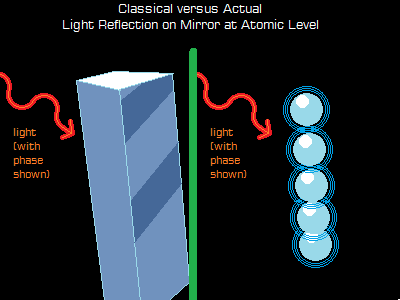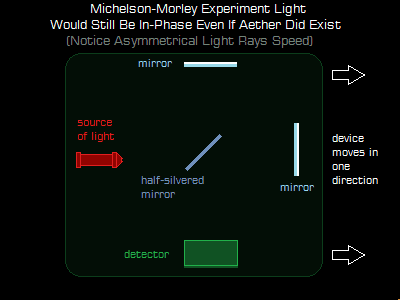It looks like you're using an Ad Blocker.
Please white-list or disable AboveTopSecret.com in your ad-blocking tool.
Thank you.
Some features of ATS will be disabled while you continue to use an ad-blocker.
share:
I don't believe in the existence of an aether (a medium permeating space and which supposedly carries light, just like air carries sound), in fact I
have often criticised the idea. However, there's some evidence that a famous experiment supposed to disprove aether might be flawed.
The Michelson-Morley Experiment was a machine designed in late 1800s aimed at measuring aether. It sends light (split into two beams, using mirrors, and reflected into a cross shape) to a detector.

The idea is that since light is supposedly carried by aether, and since the Earth (upon which the device rests) constantly moves in a direction in space, then one of the light beams would slow down relative to the other, and the two beams wouldn't reach the detector at the same time. When the experiment is carried out, over and over again, the two beams reach the detector at the exact same speed. We assume it's the same speed, because their phases (the "ripples" they have as they travel in space) are in-sync when they reach the detector.

The outcome of the experiment is widely used as a proof that light cannot slow down, and Einstein's entire Special Relativity theory is based upon this very "constancy of the speed of light".
However the entire experiment might have been flawed from the very start.
I've had the pleasure to have some pretty cool conversations with my friend Dr Delbert Larson, PhD, about physics. He pointed out something pretty important we've been missing in the experiment: the light beams have their phase reset at the points of reflection.
Mirror atoms don't actually bounce light off - when a particle of light hits the atom of the mirror, it is actually absorbed by an electron of the atom. The electron takes a high-energy orbit. Finally, as the electron returns to its original orbit it emits a particle of light back at you, and you get a reflection. What the original Michelson-Morley experiment ignores is that when that happens, the phase of the new, re-emitted light is reset.

Therefore, the detector will always see in-sync phases, and the whole experiment would fail to detect aether even if it did existed. There would be no interference measured from the beams by the detectors since the two beams would have their phase reset, starting at their reflection from the mirrors. The reason why the M.-M. Experiment didn't account for this is because quantum mechanics and the inner working of atoms had not yet been discovered at that time.

Read More
Presented with Larson's argument, I had to concede he had a pretty good point. It's undeniable phase reset occurs at the mirror's atomic level, and if that's true then the whole Michelson-Morley Experiment was flawed and thus inadequate at measuring aether to begin with; a bit like taking a kitchen scale to try and measure the weight of a water molecule.
Anyway, I just thought that I'd share this awesome thought with you guys. Now you've got some nerdy argument next time your physics teacher tries to make you disprove aether using the M.-M. Experiment!
The Michelson-Morley Experiment was a machine designed in late 1800s aimed at measuring aether. It sends light (split into two beams, using mirrors, and reflected into a cross shape) to a detector.

The idea is that since light is supposedly carried by aether, and since the Earth (upon which the device rests) constantly moves in a direction in space, then one of the light beams would slow down relative to the other, and the two beams wouldn't reach the detector at the same time. When the experiment is carried out, over and over again, the two beams reach the detector at the exact same speed. We assume it's the same speed, because their phases (the "ripples" they have as they travel in space) are in-sync when they reach the detector.

The outcome of the experiment is widely used as a proof that light cannot slow down, and Einstein's entire Special Relativity theory is based upon this very "constancy of the speed of light".
However the entire experiment might have been flawed from the very start.
I've had the pleasure to have some pretty cool conversations with my friend Dr Delbert Larson, PhD, about physics. He pointed out something pretty important we've been missing in the experiment: the light beams have their phase reset at the points of reflection.
Mirror atoms don't actually bounce light off - when a particle of light hits the atom of the mirror, it is actually absorbed by an electron of the atom. The electron takes a high-energy orbit. Finally, as the electron returns to its original orbit it emits a particle of light back at you, and you get a reflection. What the original Michelson-Morley experiment ignores is that when that happens, the phase of the new, re-emitted light is reset.

Therefore, the detector will always see in-sync phases, and the whole experiment would fail to detect aether even if it did existed. There would be no interference measured from the beams by the detectors since the two beams would have their phase reset, starting at their reflection from the mirrors. The reason why the M.-M. Experiment didn't account for this is because quantum mechanics and the inner working of atoms had not yet been discovered at that time.

Read More
Presented with Larson's argument, I had to concede he had a pretty good point. It's undeniable phase reset occurs at the mirror's atomic level, and if that's true then the whole Michelson-Morley Experiment was flawed and thus inadequate at measuring aether to begin with; a bit like taking a kitchen scale to try and measure the weight of a water molecule.
Anyway, I just thought that I'd share this awesome thought with you guys. Now you've got some nerdy argument next time your physics teacher tries to make you disprove aether using the M.-M. Experiment!
Hey, I like the idea behind your theory. Since recently hearing about the m-m experiment I've been wondering about possible reasons why it wasn't
detecting the earths movement through the aether.
I am a believer of the aether and I only say this because ring laser gyroscopes used in modern aircrafts use a much more high tech version of the m-m experiment which supposedly couldn't work without the aether (unless I'm mistaken and there is another influence involved).
That being said I'm not a physicist and maybe your explanation goes some way to describing why a motionless experiment produces a negative result whereas the same experiment in constant rotation produces a positive result. It could well be something in the way the light is reflected from the mirror
I am a believer of the aether and I only say this because ring laser gyroscopes used in modern aircrafts use a much more high tech version of the m-m experiment which supposedly couldn't work without the aether (unless I'm mistaken and there is another influence involved).
That being said I'm not a physicist and maybe your explanation goes some way to describing why a motionless experiment produces a negative result whereas the same experiment in constant rotation produces a positive result. It could well be something in the way the light is reflected from the mirror
What would an empirical experiment that does take the absorption and emission into account consist of hypothetically? And has anything since then been
done - intentionally or otherwise (perhaps as part of something entirely unrelated but that makes use of the same principles) - that meets those
criteria?
Also, does this satisfactorily address this question: arxiv.org...
Peace.
Also, does this satisfactorily address this question: arxiv.org...
Peace.
originally posted by: AceWombat04
What would an empirical experiment that does take the absorption and emission into account consist of hypothetically? And has anything since then been done - intentionally or otherwise (perhaps as part of something entirely unrelated but that makes use of the same principles) - that meets those criteria?
I don't know yet. Obviously the first answer that comes to mind is to remove the mirrors altogether, so to prevent the mirrors from forming the nodes in the light beams. Which would mean using two lasers, directly aiming at the detector, instead of as single reflected light beam. But to synchronise the lasers phases would be a major pain.
a reply to: swanne
A mirror won't do what you profess. Two out of phase light beams will reflect with the same difference in phase as their incident phases. The electric fields are reversed whilst the magnet field remains the same, at least with a normal dielectric mirror. LIGO is a M-M interferometer, although much more advanced.
A mirror won't do what you profess. Two out of phase light beams will reflect with the same difference in phase as their incident phases. The electric fields are reversed whilst the magnet field remains the same, at least with a normal dielectric mirror. LIGO is a M-M interferometer, although much more advanced.
edit on 2/2/2017 by EasyPleaseMe because: (no reason given)
originally posted by: EasyPleaseMe
a reply to: swanne
A mirror won't do what you profess. Two out of phase light beams will reflect with the same phase as their incident phase.
The same wavelength, yes, the same incident angle, yes. But same phase? How can it reflects the phase of a photon which doesn't exist since the photon has been absorbed by the atom's electrons before re-emission? Light isn't like sound - it doesn't just "bounce off" atoms. It actually is absorbed by the atom and the reflection is light which the electron emits upon returning to its original energy state.
a reply to: swanne
Imagine two single photons with electric fields in phase. They travel two different paths and return to close points on a mirror. One path takes a slightly longer time than the other, resulting in slight different absorption and emission times and hence a maintained phase difference, the same a the phase difference just before hitting the mirror.
I edited my original post while you where replying to make it more clear.
Imagine two single photons with electric fields in phase. They travel two different paths and return to close points on a mirror. One path takes a slightly longer time than the other, resulting in slight different absorption and emission times and hence a maintained phase difference, the same a the phase difference just before hitting the mirror.
I edited my original post while you where replying to make it more clear.
edit on 2/2/2017 by EasyPleaseMe because: (no reason given)
originally posted by: swanne
The outcome of the experiment is widely used as a proof that light cannot slow down, and Einstein's entire Special Relativity theory is based upon this very "constancy of the speed of light".
However the entire experiment might have been flawed from the very start.
been noticing over the past few years a lot of flawed experiments of old really screwing up the basis of science of today. job security i suppose..
S&F
a reply to: EasyPleaseMe
Yes, a different emission time. This does not translate into a phase shift. Imagine an electromagnetic wave with wavelength = 1 m being emitted from a source, and with the phase = 0 at the point of emission. Place a detector at one meter from the source. After one meter of travel, the wave phase will return to zero, and reach the detector placed there. Shooting the wave at different time (changing the emission time) will not result in phase shift - the nodes will still be located at the source and at the detector.
Your argument is akin to saying that plucking a guitar string at random time intervals will affect its nodes points.
Yes, a different emission time. This does not translate into a phase shift. Imagine an electromagnetic wave with wavelength = 1 m being emitted from a source, and with the phase = 0 at the point of emission. Place a detector at one meter from the source. After one meter of travel, the wave phase will return to zero, and reach the detector placed there. Shooting the wave at different time (changing the emission time) will not result in phase shift - the nodes will still be located at the source and at the detector.
Your argument is akin to saying that plucking a guitar string at random time intervals will affect its nodes points.
a reply to: swanne
What you say is true. However, if you simultaneously emit another photon from 1.5m away, the combined amplitude at the detector will not be double or zero, which is what you are implying.
The phase difference is caused by a different distance, or a slowing of light in one direction, which was shown not to happen. We Can show these interferometers work because moving one mirror, even very slightly, changes the interference pattern.
S&F for thinking and a well written posts however.
What you say is true. However, if you simultaneously emit another photon from 1.5m away, the combined amplitude at the detector will not be double or zero, which is what you are implying.
The phase difference is caused by a different distance, or a slowing of light in one direction, which was shown not to happen. We Can show these interferometers work because moving one mirror, even very slightly, changes the interference pattern.
S&F for thinking and a well written posts however.
edit on 2/2/2017 by EasyPleaseMe because: (no reason given)
a reply to: EasyPleaseMe
Yes. Except that in the M-M experiment, the apparatuses stay at the same relative distances to the detector. The photons are all emitted (reflection = absorbtion + emission) at the same distance from the mirror to the detector, no matter the incidence angles of the two original beams.
Edit:
Hehe, thanks; and a star for your very good arguments!
Yes. Except that in the M-M experiment, the apparatuses stay at the same relative distances to the detector. The photons are all emitted (reflection = absorbtion + emission) at the same distance from the mirror to the detector, no matter the incidence angles of the two original beams.
Edit:
Hehe, thanks; and a star for your very good arguments!
edit on 2-2-2017 by swanne because: (no reason given)
a reply to: EasyPleaseMe
I was about to tell you the same thing, lol people with good manners are of a rare species.
I was about to tell you the same thing, lol people with good manners are of a rare species.
a reply to: Corruptedstructure
Well, the possible failure of the M-M experiment really has to do with the fact that quantum mechanics was discovered after the experiment was designed. The original designers had no way to know about electronic clouds and nodes in light waves.
Well, the possible failure of the M-M experiment really has to do with the fact that quantum mechanics was discovered after the experiment was designed. The original designers had no way to know about electronic clouds and nodes in light waves.
a reply to: swanne
posted this in another thread a little while ago. noticed it on youtube randomly searching today on quite a different subject. this thread made my eye catch it. thought you may like it..ignore the title.. www.youtube.com... or not..
posted this in another thread a little while ago. noticed it on youtube randomly searching today on quite a different subject. this thread made my eye catch it. thought you may like it..ignore the title.. www.youtube.com... or not..
edit on 3-2-2017 by
Corruptedstructure because: (no reason given)
edit on 3-2-2017 by Corruptedstructure because: (no reason given)
edit
on 3-2-2017 by Corruptedstructure because: (no reason given)
edit on 3-2-2017 by Corruptedstructure because: (no reason
given)
originally posted by: swanne
I don't believe in the existence of an aether (a medium permeating space and which supposedly carries light, just like air carries sound), in fact I have often criticised the idea. However, there's some evidence that a famous experiment supposed to disprove aether might be flawed.
There really isn't any, you're right. Something far easier than the M-M to set up is at your fingertips - your LCD monitor.
Aether would propagate EM as longitudinal waves. Longitudinal waves can't be polarized. Your LCD requires a polarizer to work. Polarization of propagating EM is a long known effect, we use it all the time for various designs.
I've had the pleasure to have some pretty cool conversations with my friend Dr Delbert Larson, PhD, about physics. He pointed out something pretty important we've been missing in the experiment: the light beams have their phase reset at the points of reflection.
Mirror atoms don't actually bounce light off - when a particle of light hits the atom of the mirror, it is actually absorbed by an electron of the atom. The electron takes a high-energy orbit. Finally, as the electron returns to its original orbit it emits a particle of light back at you, and you get a reflection. What the original Michelson-Morley experiment ignores is that when that happens, the phase of the new, re-emitted light is reset.
Except that's not how mirrors work. Claiming that it DOES work that way makes me raise my left eyebrow a cm.
Absorption and re-emission of a photon does happen all the time - that's true. But when an electron drops a level and re-emits, the direction and phase are totally random. It doesn't 'shoot it back at you'. So this sort of thing produces fluorescence in situations similar to your description, but not reflections.
Reflection is a surface plasmon effect, which DOES retain this information.
Therefore, the detector will always see in-sync phases...
Except for stimulated emission, you'll NEVER see in-sync phases from re-emission. So a laser can do this, but not spontaneous re-emission.
edit
on 3-2-2017 by Bedlam because: (no reason given)
new topics
-
Democrats send letter to Biden urging him to ratify Equal Rights Amendment
US Political Madness: 2 hours ago
top topics
-
Reprehensible Behavior
US Political Madness: 14 hours ago, 10 flags -
This is adorable you guys!
General Chit Chat: 13 hours ago, 8 flags -
Defending the need for adherence to Old Testament commandments under the new covenant of Christ
Conspiracies in Religions: 15 hours ago, 5 flags -
Democrats send letter to Biden urging him to ratify Equal Rights Amendment
US Political Madness: 2 hours ago, 1 flags
active topics
-
Light from Space Might Be Travelling Instantaneously
Space Exploration • 28 • : Lazy88 -
More Bad News for Labour and Rachel Reeves Stole Christmas from Working Families
Regional Politics • 9 • : covent -
Democrats send letter to Biden urging him to ratify Equal Rights Amendment
US Political Madness • 2 • : VariedcodeSole -
Post A Funny (T&C Friendly) Pic Part IV: The LOL awakens!
General Chit Chat • 7914 • : Cymru -
George Stephanopoulos and ABC agree to pay $15 million to settle Trump defamation suit
Mainstream News • 25 • : Echo007 -
Defending the need for adherence to Old Testament commandments under the new covenant of Christ
Conspiracies in Religions • 24 • : FullHeathen -
-@TH3WH17ERABB17- -Q- ---TIME TO SHOW THE WORLD--- -Part- --44--
Dissecting Disinformation • 3713 • : 777Vader -
Rant. I am sick of people saying the police are revenue raising.
Rant • 12 • : inflaymes69 -
Reprehensible Behavior
US Political Madness • 10 • : nugget1 -
Drones everywhere in New Jersey ---and Elsewhere Master Thread
Aliens and UFOs • 174 • : nugget1
